Como Woodland Project & Committee History
Included in this section:
Past Project Funding
Original Master Plan
Past Project Stories
Past Project Funding
Original Master Plan
Past Project Stories
PAST PROJECT FUNDING
- City of St. Paul CIB (for 2010/11)--------- $242,100.00
Phase 1 staging area (This grant ended up being funded with Legacy/Heritage Funds through City of St. Paul Parks and Recreation). - Environment and Natural Resources Trust Fund----- $218,000.00
Phase 2 & 3 master plan plus educational results.
Funding for our “Get Outside! Urban Woodland for City Kids” has been recommended for funding Oct. 14, 2009 by LCCMR, but additional steps still need to occur before funding is secured. The LCCMR’s recommendations will go before the Minnesota Legislature for consideration as an appropriations bill. Upon passage by both the Minnesota House and Senate, the recommendations then go before the governor for signature into law. Funds will be available July 2010.- Summary proposal: #179-F, “Get Outside! Urban Woodland for City Kids”
- Result One: Develop outdoor classroom study areas Budget: $210,500
Deliverables at the end of three years
1. Woodland and prairie restoration – 10.35 acres
Oak woodland, coniferous forest, & transitional woodland, prairie savanna, prairie meadow, and propagation garden (for local ecotype seed propagation).
2. Construction of 4,000 feet of ADA accessible trails
3. Entry signs (four) and Interpretative trail signage (~fifty)
A primary level of entry signage for casual site users, and a secondary level of interpretative trail signage (numbered posts that correspond to site guides). - Result Two: Teacher training and student involvement Budget: $8,000
Deliverables at the end of three years
1. Receive DNR School Forest status
2. Host six educator-training sessions
Designed to help educators adapt to teaching in an outdoor classroom.
- Result One: Develop outdoor classroom study areas Budget: $210,500
- Summary proposal: #179-F, “Get Outside! Urban Woodland for City Kids”
- Andersen Foundation------------------------ $ 505.00 Environmental education
- Minnesota Native Plant Society----------- $ 279.00 Environmental education
- Audubon Minnesota FY08------------------ $ 500.00 Environmental education
- St. Paul Audubon Society FY07---------- $ 1,050.00 Bird habitat research
- City of St. Paul CIB--------------------------- $ 40,000.00 Comprehensive site plan
- City of St. Paul COPP------------------------ $ 2,000.00 Environmental education
- Together Green (Audubon national)----- $ 374.85 Buckthorn bust 2008
- Grant written for U of M Science Undergraduates,but with a major benefit for CWOC Field Days..North STAR STEM Alliance---------------- $ 15,000.00 STEM & civic engagement
ORIGINAL MASTER PLAN
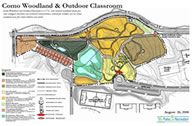
This Master Plan (16 MB) was designed by the City of Saint Paul Landscape Architects, and was made possible with funding from the City of Saint Paul Capitol Improvements Budget. The Master Plan contains the Comprehensive Site Plan, along with information about goals and objectives, site history, budget, and phasing. The Master Plan is a large PDF file, so please be patient as it downloads. Thanks!
Now that we have secured LCCMR funding, it is time to think about the timeline for the work! To learn more, please read the Work Program that was submitted with the initial application.
Now that we have secured LCCMR funding, it is time to think about the timeline for the work! To learn more, please read the Work Program that was submitted with the initial application.
PAST PROJECT STORIES
August 2012
St. Paul Elementary School has a School Forest (Released August 16, 2012)
Students and teachers at Crossroads Science and Montessori schools in St. Paul will use the Como Woodlands Outdoor Classroom as their school forest under a program offered by the Minnesota Department of Natural Resources (DNR).
The 17-acre site is owned and managed by the city of St. Paul.
Schools such as Crossroads that enroll in the School Forest program get DNR benefits, which include: skill-based teacher training on how to teach outside; access to engaging, outdoor activities that meet academic standards; assistance from DNR natural resource professionals; and access to free tree seedlings from the DNR nursery.
The School Forest program also helps ensure the school’s long-term commitment to using the outdoors by providing consistent DNR support, staff and programs, even if the school itself changes over time.
“School forests provide teachers and students with frequent, easy access into a dynamically changing environment abounding with natural lessons from trees, plants, soils, water and the animals living among them,” said Laura Duffey, DNR school forest specialist.
Because the school forest is located only 1.7 miles from the school building, Crossroads students will be able to take field trips all year long, without breaking the bank with long-distance bussing costs.
“While trips to destination environments hold a large “wow” factor, studies show that frequent trips to nearby nature increase learning more than once-a-year destination trips,” Duffey said.
Teaching outdoors is not an “add-on,” nor is it for science only, Duffey said. “Teachers will continue to teach math, science, language arts and other subjects in their outdoor classroom.”
More information about the School Forest Program is available online.
St. Paul Elementary School has a School Forest (Released August 16, 2012)
Students and teachers at Crossroads Science and Montessori schools in St. Paul will use the Como Woodlands Outdoor Classroom as their school forest under a program offered by the Minnesota Department of Natural Resources (DNR).
The 17-acre site is owned and managed by the city of St. Paul.
Schools such as Crossroads that enroll in the School Forest program get DNR benefits, which include: skill-based teacher training on how to teach outside; access to engaging, outdoor activities that meet academic standards; assistance from DNR natural resource professionals; and access to free tree seedlings from the DNR nursery.
The School Forest program also helps ensure the school’s long-term commitment to using the outdoors by providing consistent DNR support, staff and programs, even if the school itself changes over time.
“School forests provide teachers and students with frequent, easy access into a dynamically changing environment abounding with natural lessons from trees, plants, soils, water and the animals living among them,” said Laura Duffey, DNR school forest specialist.
Because the school forest is located only 1.7 miles from the school building, Crossroads students will be able to take field trips all year long, without breaking the bank with long-distance bussing costs.
“While trips to destination environments hold a large “wow” factor, studies show that frequent trips to nearby nature increase learning more than once-a-year destination trips,” Duffey said.
Teaching outdoors is not an “add-on,” nor is it for science only, Duffey said. “Teachers will continue to teach math, science, language arts and other subjects in their outdoor classroom.”
More information about the School Forest Program is available online.
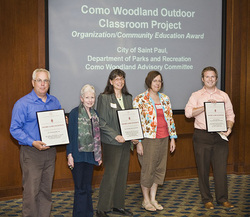
May 2012
Como Woodland Outdoor Classroom Honored
Submitted by: Susan Jane Cheney and Deb Robinson
Accepting Organization/Community Education award for their work on the Como Woodland Outdoor Classroom project are from left Dan Walesch, Susan Jane Cheney, Deb Robinson, Teri Heyer, and Bryan Murphy.
The Como Woodland Outdoor Classroom (CWOC) project was honored at the 22nd Annual Saint Paul Heritage Preservation Awards. The ceremony was held at Saint Paul City Hall on May 15, 2012. The CWOC project received an award in the Organization/Community Education category. The District 10 Como Community Council’s Environment Committee nominated the CWOC project for the award. The Saint Paul Heritage Preservation Commission and Saint Paul Chapter of the American Institute of Architects co-sponsor the Awards to recognize projects, individuals and organizations that enhance and celebrate the City’s cultural resources.
Nearly a decade ago, District 10 Environment Committee members in collaboration with St. Paul Parks and Recreation Environmental Services, began removing the buckthorn from the project’s wooded site. In 2006, volunteers formed an advisory committee that expanded the project’s mission to include educational uses for the site. The CWOC occupies and preserves the largest remaining significant woodland area of Como Park and provides a readily accessible urban site for outdoor learning.
Removal of invasive non-native species and use of the woodland as an “outdoor classroom” closely reflect the intent of William LaMont Kaufman, Superintendent of St. Paul Parks and the original designer of this area of Como Park in 1935. Kaufman had advocated the preservation of this woodland as a natural sanctuary within the city.
The CWOC concept today carries forth Kaufman’s promotion of stewardship for this important community asset. Thousands of hours of community volunteerism have already contributed to the success of this project. Furthermore, the Woodland site includes three historic features, two of which have been restored. One of these, the Joyce Kilmer Memorial Fireplace, serves as a primary meeting location in the woodland.
The awards ceremony honored volunteers of the Como Woodland Advisory Committee, the City of Saint Paul Parks and Recreation Department (Environmental Services and Design Divisions), and A & M Construction (historic restoration masons) all of which have been instrumental in the project’s development.
Como Woodland Outdoor Classroom Honored
Submitted by: Susan Jane Cheney and Deb Robinson
Accepting Organization/Community Education award for their work on the Como Woodland Outdoor Classroom project are from left Dan Walesch, Susan Jane Cheney, Deb Robinson, Teri Heyer, and Bryan Murphy.
The Como Woodland Outdoor Classroom (CWOC) project was honored at the 22nd Annual Saint Paul Heritage Preservation Awards. The ceremony was held at Saint Paul City Hall on May 15, 2012. The CWOC project received an award in the Organization/Community Education category. The District 10 Como Community Council’s Environment Committee nominated the CWOC project for the award. The Saint Paul Heritage Preservation Commission and Saint Paul Chapter of the American Institute of Architects co-sponsor the Awards to recognize projects, individuals and organizations that enhance and celebrate the City’s cultural resources.
Nearly a decade ago, District 10 Environment Committee members in collaboration with St. Paul Parks and Recreation Environmental Services, began removing the buckthorn from the project’s wooded site. In 2006, volunteers formed an advisory committee that expanded the project’s mission to include educational uses for the site. The CWOC occupies and preserves the largest remaining significant woodland area of Como Park and provides a readily accessible urban site for outdoor learning.
Removal of invasive non-native species and use of the woodland as an “outdoor classroom” closely reflect the intent of William LaMont Kaufman, Superintendent of St. Paul Parks and the original designer of this area of Como Park in 1935. Kaufman had advocated the preservation of this woodland as a natural sanctuary within the city.
The CWOC concept today carries forth Kaufman’s promotion of stewardship for this important community asset. Thousands of hours of community volunteerism have already contributed to the success of this project. Furthermore, the Woodland site includes three historic features, two of which have been restored. One of these, the Joyce Kilmer Memorial Fireplace, serves as a primary meeting location in the woodland.
The awards ceremony honored volunteers of the Como Woodland Advisory Committee, the City of Saint Paul Parks and Recreation Department (Environmental Services and Design Divisions), and A & M Construction (historic restoration masons) all of which have been instrumental in the project’s development.
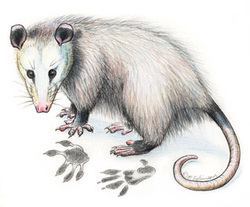
February 2012
Animal Tracks in Winter – Late Febuary Interpretive tours with Lisa Held
Written and illustrated by Deb Robinson
Learn more about Como Woodland’s animals by searching for their tracks during one of these free one-hour educational tours. Join Lisa Held, Interpretive Naturalist and Como Woodland Advisor, on Thursday February 23 at 4PM or Saturday February 25 at 10:30AM at the Como Woodland Outdoor Classroom site in Como Park.
Some woodland animals hibernate during the colder winter months. But foxes, opposums, deer, and many others are active throughout the winter – even if you rarely see the animals themselves, you can learn so much about the critters that live in this small urban forest by their tracks and the other signs they leave.
Meet your guide, Ms Held, at the recently restored Kilmer Memorial Fireplace right off Como Ave between Beulah Lane and Lexington Pkwy. Tours are free, but reservations are suggested (25 participate limit). To RSVP and for more tour information, contact Ms Held at: 651-373-0028.
Animal Tracks in Winter – Late Febuary Interpretive tours with Lisa Held
Written and illustrated by Deb Robinson
Learn more about Como Woodland’s animals by searching for their tracks during one of these free one-hour educational tours. Join Lisa Held, Interpretive Naturalist and Como Woodland Advisor, on Thursday February 23 at 4PM or Saturday February 25 at 10:30AM at the Como Woodland Outdoor Classroom site in Como Park.
Some woodland animals hibernate during the colder winter months. But foxes, opposums, deer, and many others are active throughout the winter – even if you rarely see the animals themselves, you can learn so much about the critters that live in this small urban forest by their tracks and the other signs they leave.
Meet your guide, Ms Held, at the recently restored Kilmer Memorial Fireplace right off Como Ave between Beulah Lane and Lexington Pkwy. Tours are free, but reservations are suggested (25 participate limit). To RSVP and for more tour information, contact Ms Held at: 651-373-0028.
March 2011
Poet-tree Workshops a success and the Kilmer Fireplace restoration begins
Update by: Deb Robinson, Como Woodland Advisory Committee volunteer
Download full article
In the Fall of 2010, the weather was picture perfect for the Como Woodland tours leading up to the Poet‐tree Workshops. Taking the students outdoors to learn about local history and natural history through poetry helped the kids contextualize and retain the information that was provided. And, of course, the kids enjoyed the fresh air and exercise as well.
During their walk to the Como Woodland Outdoor Classroom site, the students were in high spirits ‐ excited to be outside. The walking tours were designed to acquaint the 139 fifth and sixth grade students with Como Woodland, Kilmer Memorial Fireplace, and the many benefits of trees...
Poet-tree Workshops a success and the Kilmer Fireplace restoration begins
Update by: Deb Robinson, Como Woodland Advisory Committee volunteer
Download full article
In the Fall of 2010, the weather was picture perfect for the Como Woodland tours leading up to the Poet‐tree Workshops. Taking the students outdoors to learn about local history and natural history through poetry helped the kids contextualize and retain the information that was provided. And, of course, the kids enjoyed the fresh air and exercise as well.
During their walk to the Como Woodland Outdoor Classroom site, the students were in high spirits ‐ excited to be outside. The walking tours were designed to acquaint the 139 fifth and sixth grade students with Como Woodland, Kilmer Memorial Fireplace, and the many benefits of trees...
Feb. 11, 2011
Saint Paul’s Como Park Receives $218,000 Grant
City press release by Brad Meyer.
Saint Paul’s Como Park Receives $218,000 Grant Restoration work will clean-up and bring environmental education to urban outdoor classroom (Saint Paul) - Restoration work is set to begin on the Como Woodland Outdoor Classroom. The City of Saint Paul received a $218,000 grant from the Minnesota Environment and Natural Resources Trust Fund to transform a 17.75-acre woodland located within Como Regional Park into the Como Woodland Outdoor Classroom. This classroom will provide environmental education and historical interpretation for school children and adults, habitat for native wildlife, and an urban woodland oasis for the inner-city community where local place-based, hands-on environmental learning opportunities are rare.
Mayor Coleman has long championed Saint Paul’s award winning parks system remarking, "The parks system in Saint Paul is second to none and this grant will allow us to further that tradition of excellence. With the support of the Minnesota Environment and Natural Resources Trust Fund, our Parks and Recreation Department will transform Como Regional Park by cleaning-up the woodlands and expanding environmental education. This outdoor classroom will become a destination for local families, furthering Saint Paul as a great place to work, live and play."
Community volunteers have long been involved in removing invasive species from the woodlands within Como Regional Park. This new funding will allow the City to complete invasive species removal within the Como Woodland Outdoor Classroom, and develop six study areas representing six unique plant communities found in Minnesota.
As work begins on constructing the Como Woodland Outdoor Classroom, residents and visitors to Como Regional Park will notice some changes. Beginning later this month, Conservation Corps Minnesota will be selectively removing invasive trees per the Como Woodland Outdoor Classroom Master Plan.
Funding to create this rare asset was provided by the Minnesota Environment and Natural Resources Trust Fund as recommended by the Legislative-Citizen Commission on Minnesota Resources (LCCMR). The Trust Fund is a permanent fund constitutionally established by the citizens of Minnesota to assist in the protection, conservation, preservation, and enhancement of the states air, water, land, fish, wildlife, and other natural resources. Currently 40% of net Minnesota State Lottery proceeds are dedicated to building the Trust Fund and ensuring future benefits for Minnesota's environment and natural resources.
Saint Paul’s Como Park Receives $218,000 Grant
City press release by Brad Meyer.
Saint Paul’s Como Park Receives $218,000 Grant Restoration work will clean-up and bring environmental education to urban outdoor classroom (Saint Paul) - Restoration work is set to begin on the Como Woodland Outdoor Classroom. The City of Saint Paul received a $218,000 grant from the Minnesota Environment and Natural Resources Trust Fund to transform a 17.75-acre woodland located within Como Regional Park into the Como Woodland Outdoor Classroom. This classroom will provide environmental education and historical interpretation for school children and adults, habitat for native wildlife, and an urban woodland oasis for the inner-city community where local place-based, hands-on environmental learning opportunities are rare.
Mayor Coleman has long championed Saint Paul’s award winning parks system remarking, "The parks system in Saint Paul is second to none and this grant will allow us to further that tradition of excellence. With the support of the Minnesota Environment and Natural Resources Trust Fund, our Parks and Recreation Department will transform Como Regional Park by cleaning-up the woodlands and expanding environmental education. This outdoor classroom will become a destination for local families, furthering Saint Paul as a great place to work, live and play."
Community volunteers have long been involved in removing invasive species from the woodlands within Como Regional Park. This new funding will allow the City to complete invasive species removal within the Como Woodland Outdoor Classroom, and develop six study areas representing six unique plant communities found in Minnesota.
As work begins on constructing the Como Woodland Outdoor Classroom, residents and visitors to Como Regional Park will notice some changes. Beginning later this month, Conservation Corps Minnesota will be selectively removing invasive trees per the Como Woodland Outdoor Classroom Master Plan.
Funding to create this rare asset was provided by the Minnesota Environment and Natural Resources Trust Fund as recommended by the Legislative-Citizen Commission on Minnesota Resources (LCCMR). The Trust Fund is a permanent fund constitutionally established by the citizens of Minnesota to assist in the protection, conservation, preservation, and enhancement of the states air, water, land, fish, wildlife, and other natural resources. Currently 40% of net Minnesota State Lottery proceeds are dedicated to building the Trust Fund and ensuring future benefits for Minnesota's environment and natural resources.
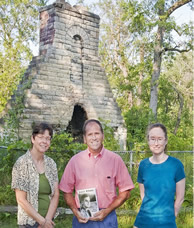
July 2010
Joyce Kilmer biographer, John Covell, speaks at July 2010 Advisors’ meeting
Read the full story by Deb Robinson: PDF 116KB
In the spring of 1936, the WPA built a memorial fireplace with funds donated by the Joyce Kilmer American Legion Post. Over time, the fireplace fell into disrepair. Its true name was largely forgotten and the fireplace became known locally as the “Dutch Oven.” But Kilmer’s name is being restored along with the fireplace.
On July 12, 2010, John Covell, Joyce Kilmer biographer, visited the Joyce Kilmer Memorial Fireplace. Covell had traveled from Texas to the Como Streetcar Station as the guest speaker for the Como Woodland Outdoor Classroom Advisory meeting . . .
Joyce Kilmer biographer, John Covell, speaks at July 2010 Advisors’ meeting
Read the full story by Deb Robinson: PDF 116KB
In the spring of 1936, the WPA built a memorial fireplace with funds donated by the Joyce Kilmer American Legion Post. Over time, the fireplace fell into disrepair. Its true name was largely forgotten and the fireplace became known locally as the “Dutch Oven.” But Kilmer’s name is being restored along with the fireplace.
On July 12, 2010, John Covell, Joyce Kilmer biographer, visited the Joyce Kilmer Memorial Fireplace. Covell had traveled from Texas to the Como Streetcar Station as the guest speaker for the Como Woodland Outdoor Classroom Advisory meeting . . .
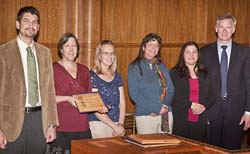
April 28, 2010
Como Woodland Outdoor Classroom recieves theSustainable Saint Paul Award for Green Spaces from Mayor Chris Coleman.
The awards pay tribute to individuals and organizations that have demonstrated a commitment to environmental stewardship through leadership in their respective categories. These efforts enhance the City’s quality of life and make Saint Paul the Most Livable City in America. The Green Spaces Award honors community groups and residents who replant, restore, and reclaim the urban environment into opportunities for the social and physical renewal. See it all on YouTube.
Como Woodland Outdoor Classroom recieves theSustainable Saint Paul Award for Green Spaces from Mayor Chris Coleman.
The awards pay tribute to individuals and organizations that have demonstrated a commitment to environmental stewardship through leadership in their respective categories. These efforts enhance the City’s quality of life and make Saint Paul the Most Livable City in America. The Green Spaces Award honors community groups and residents who replant, restore, and reclaim the urban environment into opportunities for the social and physical renewal. See it all on YouTube.
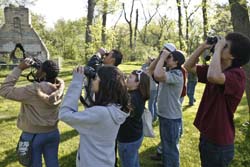
May 2008
Spring into summer from May to July - Field Day birding
Read the full story by Deb Robinson: PDF220k
High school students have been monitoring 14 study plots in the Como Woodland since the Fall Field Day last October. On Spring Field Day this May 23, the students returned to their study plots again to identify species and densities of trees, forbs, lichen colonies, and earthworms. This is a long-term study, and the data the students collect will be used to monitor changes in the woodland during the restoration process. On this field day a new element was added – a bird survey. And the number of bird species sighted that morning was a pleasant surprise . . .
Spring into summer from May to July - Field Day birding
Read the full story by Deb Robinson: PDF220k
High school students have been monitoring 14 study plots in the Como Woodland since the Fall Field Day last October. On Spring Field Day this May 23, the students returned to their study plots again to identify species and densities of trees, forbs, lichen colonies, and earthworms. This is a long-term study, and the data the students collect will be used to monitor changes in the woodland during the restoration process. On this field day a new element was added – a bird survey. And the number of bird species sighted that morning was a pleasant surprise . . .
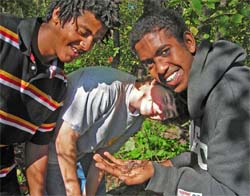
November 11, 2007
Como Park High School Students Have a Field Day
Read the full story by Deb Robinson: PDF 82k
Removing piles of invasive buckthorn shrubs from the woods is hard, but satisfying work.On October 27, over 165 volunteers came to Como Park to do just that, and most of the volunteers were teenagers.Como Park High School students are turning out to be the real local heroes of Como Park’s woodland restoration efforts, but they are putting in more than one day a year for the benefit of the park’s woodlands. The students have embarked on a long-term ecological research project to measure changes in the Como Woodland during the restoration process.
View a Minnesota Bound video segment about the day . . .
Como Park High School Students Have a Field Day
Read the full story by Deb Robinson: PDF 82k
Removing piles of invasive buckthorn shrubs from the woods is hard, but satisfying work.On October 27, over 165 volunteers came to Como Park to do just that, and most of the volunteers were teenagers.Como Park High School students are turning out to be the real local heroes of Como Park’s woodland restoration efforts, but they are putting in more than one day a year for the benefit of the park’s woodlands. The students have embarked on a long-term ecological research project to measure changes in the Como Woodland during the restoration process.
View a Minnesota Bound video segment about the day . . .
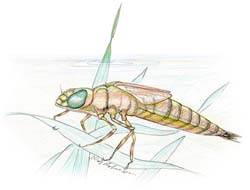
October 2007
Como Woodland advisors and volunteers branch out to help with a Macroinvertebrate Study of Como Lake -
Red the full story by Deb Robinson: PDF36k
Over the past five months Dr. McKearnan, EcoParnters staff and interns, and volunteers have been collecting monthly water samples from five locations along Como Lake’s shore. The subjects of the study has been the aquatic insects, worms, leeches, mollusks, and other invertebrates that live at least part of their life cycle in the waters of Como Lake. The Final Report is available through this link
Como Woodland advisors and volunteers branch out to help with a Macroinvertebrate Study of Como Lake -
Red the full story by Deb Robinson: PDF36k
Over the past five months Dr. McKearnan, EcoParnters staff and interns, and volunteers have been collecting monthly water samples from five locations along Como Lake’s shore. The subjects of the study has been the aquatic insects, worms, leeches, mollusks, and other invertebrates that live at least part of their life cycle in the waters of Como Lake. The Final Report is available through this link
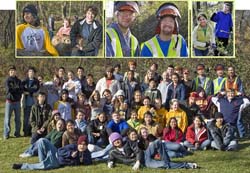
November 2006
Como Woodland Restoration Outdoor Classroom Project Begins
Read the full story by Deb Robinson: PDF 92k
Our cities would be a much poorer place without our public parks and open spaces. The natural settings they provide are clearly important to our well-being,but urban forests have become rare. However, an idea for restoring a little wooded corner of Como Park and opening it up for educational purposes has been slowly taking shape in the minds of a small group of local volunteers. The high spirits of the 65 Como High School students and Fresh Force servicelearning students was contagious on the morning of October 28th .
Como Woodland Restoration Outdoor Classroom Project Begins
Read the full story by Deb Robinson: PDF 92k
Our cities would be a much poorer place without our public parks and open spaces. The natural settings they provide are clearly important to our well-being,but urban forests have become rare. However, an idea for restoring a little wooded corner of Como Park and opening it up for educational purposes has been slowly taking shape in the minds of a small group of local volunteers. The high spirits of the 65 Como High School students and Fresh Force servicelearning students was contagious on the morning of October 28th .
